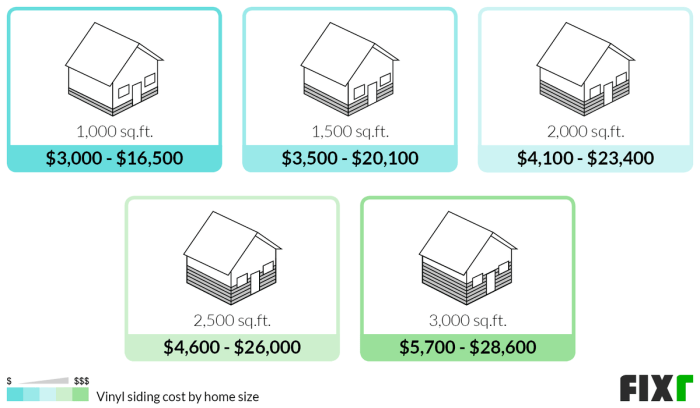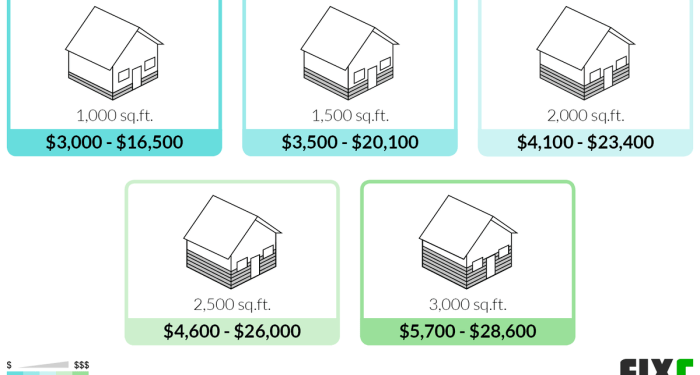Delving into the realm of vinyl siding installation costs, this article sheds light on the various factors that influence pricing, the breakdown of average costs, and comparisons between different types of vinyl siding. Stay tuned for valuable insights!
Factors Affecting Vinyl Siding Installation Costs
When it comes to determining the cost of installing vinyl siding, several factors come into play, affecting the overall price of the project. Understanding these factors is crucial for homeowners looking to budget for a vinyl siding installation.
Size of the House
The size of the house is a major factor influencing the cost of installing vinyl siding. Larger homes will require more materials and labor, resulting in higher installation costs. Smaller homes, on the other hand, will generally cost less to side.
Type of Vinyl Siding Chosen
The type of vinyl siding chosen also plays a significant role in determining the installation cost. Higher quality and more durable vinyl siding options will typically come with a higher price tag. Additionally, specialty finishes or styles may also increase the overall cost.
Labor Costs
Labor costs can vary depending on the complexity of the installation, the experience of the contractors, and the location of the home. More experienced contractors may charge higher rates, but they often deliver high-quality workmanship that justifies the cost.
Additional Costs
In addition to the basic materials and labor, there are several additional costs that can impact the overall price of vinyl siding installation. These costs may include the removal of old siding, insulation installation, and trim work. Each of these additional tasks adds to the total cost of the project but is essential for a successful vinyl siding installation.
Average Cost Breakdown for Vinyl Siding Installation
When it comes to installing vinyl siding, understanding the breakdown of costs can help homeowners budget effectively and make informed decisions. Here is a detailed breakdown of the average costs involved in vinyl siding installation:
Cost Categories
| Cost Category | Percentage/Dollar Amount | Contribution to Total Price |
|---|---|---|
| Materials | 60% | The cost of vinyl siding materials accounts for the largest portion of the total price. This includes the siding panels, trim pieces, and any additional accessories required for installation. |
| Labor | 30% | Labor costs cover the installation of the siding, which involves preparing the surface, cutting and fitting the panels, and ensuring proper insulation and finishing. |
| Permits | 5% | Permit fees are necessary for many vinyl siding installations to comply with local building codes and regulations. These fees vary depending on the location. |
| Additional Expenses | 5% | Additional expenses may include equipment rental, disposal of old siding, and unexpected repairs or modifications required during installation. |
Comparing Different Types of Vinyl Siding and Their Installation Costs
When it comes to vinyl siding, there are various types available in the market, each with its own set of features and costs. Understanding the differences between basic vinyl siding and premium options can help you make an informed decision based on your budget and preferences.
Basic Vinyl Siding vs. Premium Options
- Basic vinyl siding: This type of siding is the most affordable option and typically comes in standard colors and styles. Installation costs are usually lower due to the simplicity of the material.
- Premium vinyl siding: Premium options may include features such as enhanced durability, better insulation properties, and a wider range of colors and textures. The installation cost for premium vinyl siding is higher due to the added benefits and quality of the material.
Insulated Vinyl Siding
Insulated vinyl siding is designed to improve energy efficiency by providing better insulation for your home. While the upfront cost of insulated siding may be higher than traditional options, the long-term savings on energy bills can make it a cost-effective choice in the long run.
Textured Options and Colors
- Textured vinyl siding: Textured options can mimic the look of wood or other materials, adding visual interest to your home’s exterior. The cost of textured vinyl siding may be higher than smooth options due to the added design elements.
- Colors: Choosing a custom color for your vinyl siding can also impact the installation cost. While standard colors may be included in the base price, opting for premium or custom colors can result in additional expenses.
Quality and Features Impact on Installation Cost
- The quality of vinyl siding, including its thickness, durability, and warranty, can affect the installation cost. Higher quality materials may have a higher upfront cost but can result in lower maintenance expenses in the long term.
- Features such as UV protection, impact resistance, and ease of maintenance can also influence the installation cost. Investing in premium features can enhance the longevity and appearance of your vinyl siding, but it may come at a higher price.
DIY vs. Professional Installation
When it comes to installing vinyl siding, homeowners often face the decision of whether to tackle the project themselves or hire professionals. Each option has its own set of advantages and disadvantages, particularly in terms of cost.
Advantages and Disadvantages of DIY Vinyl Siding Installation
DIY installation of vinyl siding can potentially save homeowners a significant amount of money. By eliminating labor costs, you can reduce the overall expenses associated with the project. Additionally, taking on the installation yourself gives you full control over the process and timeline.
However, DIY installation requires a certain level of skill and knowledge. Mistakes made during the installation process can lead to costly repairs down the line. Inexperienced homeowners may also take longer to complete the project, resulting in extended timelines and potential frustration.
Potential Savings or Extra Expenses with Professional Installation
While hiring professionals for vinyl siding installation comes with a higher upfront cost due to labor expenses, it may actually save you money in the long run. Professional installers have the expertise to complete the job efficiently and correctly the first time, reducing the likelihood of costly mistakes and repairs.
On the other hand, hiring professionals means relinquishing some control over the project and timeline. Additionally, you may need to budget for additional expenses such as permits, disposal of old materials, and potential unforeseen issues that arise during installation.
Tips on When to Opt for Professional Installation
It is advisable to opt for professional installation when the complexity of the project exceeds your skill level, or when time constraints are a concern. Professional installers can complete the job quickly and accurately, ensuring a seamless finish without the risk of errors.
Furthermore, if the cost of purchasing or renting specialized tools for DIY installation is significant, hiring professionals may be a more cost-effective option. Consider obtaining quotes from multiple contractors to compare prices and services before making a decision.
Regional Variances in Vinyl Siding Installation Prices

When it comes to the cost of installing vinyl siding, regional variations play a significant role in determining the final price. Factors such as location, climate, local labor rates, and demand for siding services can all impact the overall cost.
Impact of Location on Vinyl Siding Installation Costs
Location has a direct influence on vinyl siding installation prices. Urban areas tend to have higher labor rates and material costs compared to rural areas. For example, installing vinyl siding in a bustling city like New York will likely cost more than in a small town in Kansas.
Climate Considerations
The climate of a region can also affect the cost of vinyl siding installation. Areas with extreme weather conditions may require additional insulation or special siding materials, increasing the overall cost of the project.
Regional Demand for Siding Services
The demand for siding services in a particular region can impact pricing as well. Higher demand can lead to increased labor costs and longer wait times for installation, ultimately affecting the total cost of the project.
End of Discussion
Wrapping up our discussion on vinyl siding installation prices, we’ve covered essential aspects like regional variances, DIY vs. professional installation, and the impact of different siding types. Hopefully, you now have a clearer picture of what to expect when considering vinyl siding for your home.
FAQ Explained
What factors can affect the cost of vinyl siding installation?
Factors like house size, type of vinyl siding, and labor costs play a significant role in determining the overall installation price.
How do regional variances impact vinyl siding installation prices?
Location-specific factors such as climate, labor rates, and demand for siding services can lead to price variations across different regions.
Is DIY vinyl siding installation cost-effective compared to hiring professionals?
While DIY can save money upfront, professional installation ensures quality work and may be more cost-effective in the long run.














